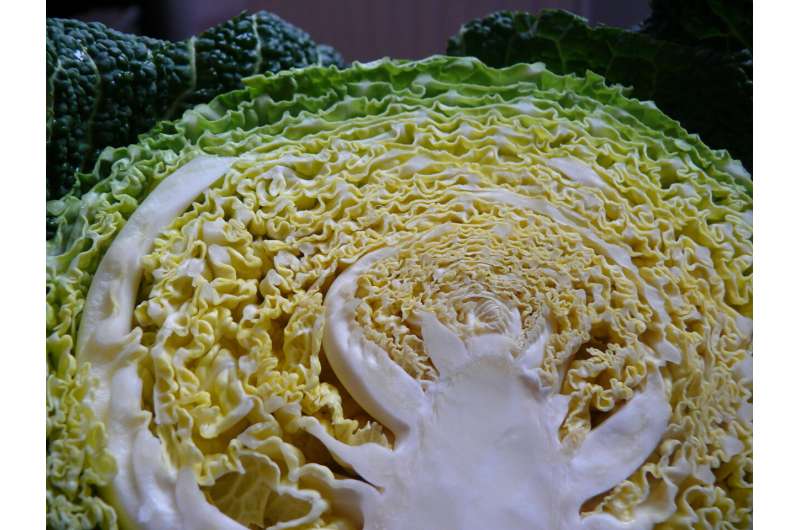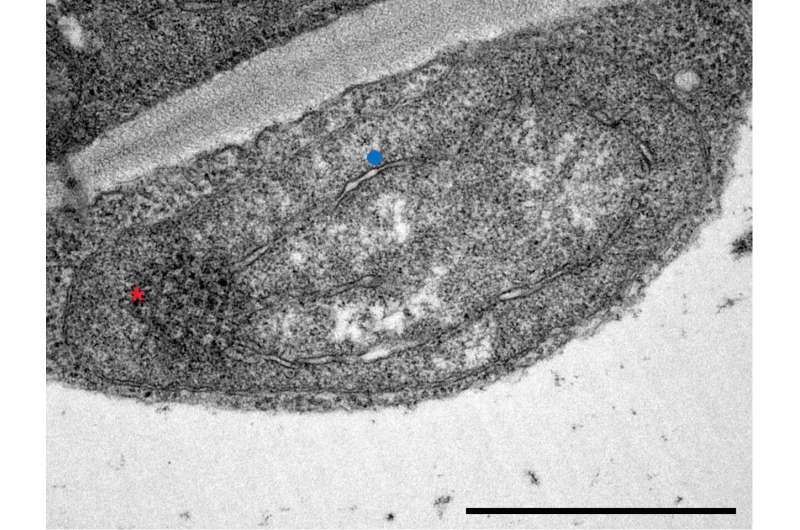This article has been reviewed according to Science X's editorial process and policies. Editors have highlighted the following attributes while ensuring the content's credibility:
fact-checked
peer-reviewed publication
trusted source
proofread
Special iron uptake method discovered deep inside the Savoy cabbage head

A surprising twist has been found in a study by researchers at Eötvös Loránd University (ELTE), published in the journal Frontiers in Plant Science. Their research has revealed that the mechanism of iron uptake by plastids in the absence of light is similar to the process facilitated by photosynthesis. Their discovery could have implications for our food and health knowledge and its applications, as our plant foods and their plastids represent an important source of iron for humans.
Iron is one of the most important mineral nutrients for living organisms. It is therefore essential in both humans and plants for enzymes involved in crucial life processes such as cellular respiration or photosynthesis. Iron incorporation into these enzymes is thus essential for the metabolism.
Photosynthesis—the metabolic process that uses sunlight energy to produce organic matter from carbon dioxide and water in plants—therefore requires iron. Since photosynthesis takes place inside chloroplasts, within the plant cell iron must be transported into these organelles. At the Department of Plant Physiology and Molecular Plant Biology of the Eötvös Loránd University, Dr. Ádám Solti and his research team have been investigating the molecular processes that enable iron uptake of chloroplasts for many years.
"Because of the importance of photosynthesis, we know a lot about photosynthetically active plastids and have been studying their iron uptake for a long time. Iron uptake by chloroplasts requires light. However,
it has been a long-standing question whether iron uptake in plant tissues that are not exposed to sunlight is the same as in chloroplasts"
explains the basic idea of the research Máté Sági-Kazár, Ph.D. student. All that was needed was a suitable research object from which large quantities of plastids of different developmental stages could be isolated for the investigation. The test object was practically lying on the (kitchen) table.

We all know Savoy cabbage well. The Savoy cabbage heads are huge, modified buds, from the stalk of which arise a number of leaves of different color and of different developmental stages.
In a half-cut Savoy cabbage head, you can see that the outer leaves, exposed to the light, are green, but as we move inwards, the leaves gradually fade, and the innermost, smallest and youngest leaves are white-yellowish. This phenomenon is related to the fact that in the absence of light, angiosperm plants cannot produce chlorophyll, the green pigment, and without it they cannot photosynthesize.
"The inner leaves of cabbage heads are practically shaded by the outer green leaves, blocking them from light, so that a light deficit gradually develops moving inwards inside the heads. Instead of the accumulation of green chlorophylls in the inner leaf layers, we can only see the yellowish color of the carotenoids present, and special types of photosynthetically inactive plastids, the so-called etioplasts, develop in them, as described earlier in the case of white cabbage," explains Dr. Katalin Solymosi, one of the participants in the research, while talking about the advantages of the plant used for the experiments.
This multi-institutional and multi-researcher study has therefore investigated the iron uptake mechanisms of the plastids of leaves that are photosynthetically inactive, and has compared them with those that are. The physiological processes observed for the first time showed that the uptake of iron by the plastids follows exactly—although to a lesser extent—the same principle as that characterizing chloroplasts.
"During the past fifteen years, the uptake of iron by chloroplasts was thought to be exclusively linked to photosynthesis and, to a lesser extent, to the direct chemical reduction of iron by sunlight. The results of our studies have brought about a surprising change in what we previously knew about the vital nutrient homeostasis of organelles," summarized Dr. Ádám Solti, the leader of the research.
All these basic research-type scientific studies are of particular interest to the food industry and health care, as our plant-based foods and their plastids represent an important source of iron for humans. Therefore, it is important to understand which factors play an important role in the uptake and accumulation of iron in plastids and how it may be improved or regulated.
More information: Máté Sági-Kazár et al, Iron uptake of etioplasts is independent from photosynthesis but applies the reduction-based strategy, Frontiers in Plant Science (2023). DOI: 10.3389/fpls.2023.1227811
Journal information: Frontiers in Plant Science
Provided by Eötvös Loránd University


















